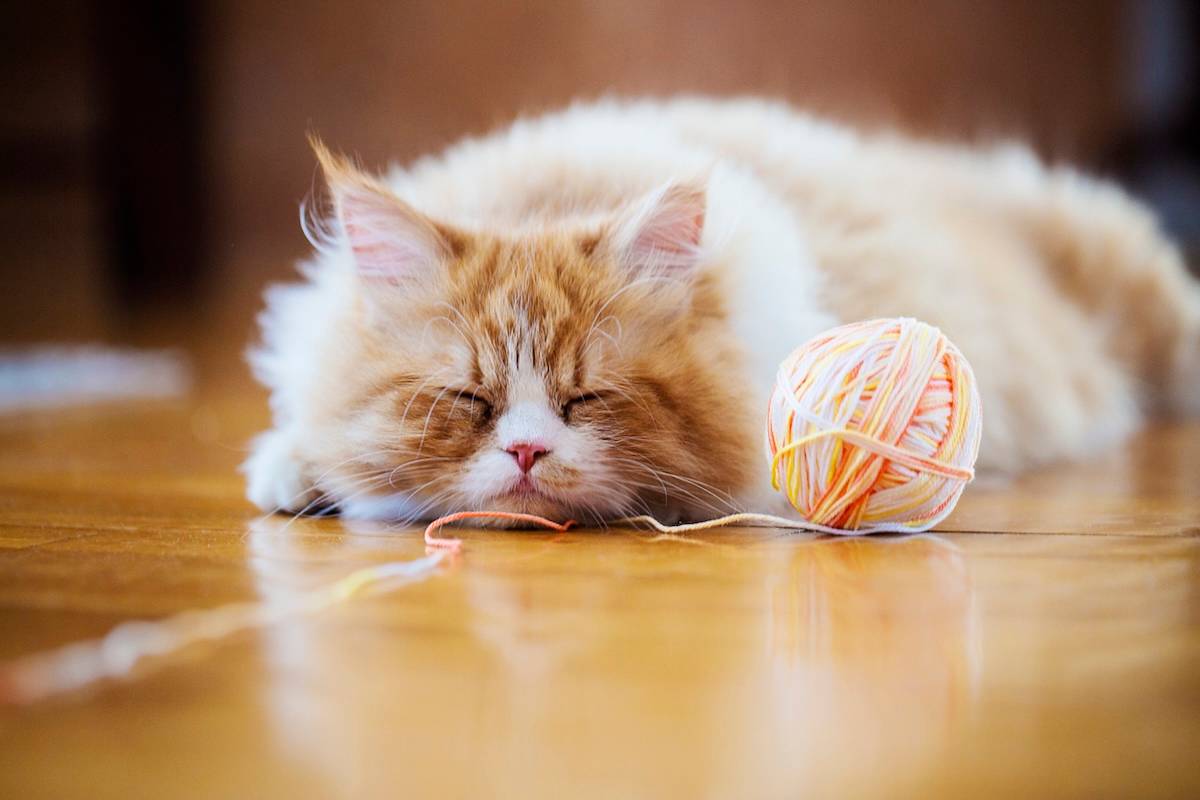Playtime For Golden Girls & Boys: Fun Ways to Keep Your Senior Cat Engaged
Retired, not expired!
You may have noticed your cat slowing down a bit as they enter their twilight years, but that doesn’t mean they’ve lost interest in the world around them. Even in their senior years, cats still need ways to stay mentally engaged. Play is an important piece of that puzzle.
Why older cats need play
Play is essential for any animal’s overall well-being – not just for physical exercise, but also as a powerful mood booster, confidence builder and stress reliever.
Get (totally free) deals for food, treats, accessories, tech and way more pet parenting must-haves.
For senior cats, gentle, age-appropriate play supports physical health by helping maintain muscle tone, co-ordination and flexibility, reducing the risk of weight gain and joint stiffness. It also provides a safe outlet for natural behaviours like chasing and exploring in a safe, low-impact way.
Mentally, play stimulates curiosity and problem-solving, helping to keep the brain sharp while reducing boredom and stress. It also acts as a counter to negative emotional states like fear or anxiety, contributing to a calmer, happier mood overall.
Why older cats stop playing
As cats grow older, they may start to play less. This can be due to a combination of physical, mental and health-related factors that come naturally with age.
Common reasons include:
Joint pain or arthritis
Painful joints can make jumping, chasing or even light movement uncomfortable.
Reduced mobility and muscle loss
Weakened muscles and decreased flexibility can limit stamina and agility.
Cognitive decline
Age-related changes in memory or focus may reduce curiosity and interest in play.
Chronic health conditions
Issues like obesity, dental disease, or other illnesses can drain energy and increase the need for rest.
Diminished senses
Declining vision or hearing can make it harder for your cat to track toys or respond to movement.
You may notice your senior cat is still alert but ignores toys they used to love. Perhaps they choose napping more often than heading outside to explore the yard. Changes like these are not uncommon as their needs shift with age.
Low-impact play activities and toys for senior cats
While older cats may not leap and dash about like they once did, they can still enjoy, and benefit from, playing. The key is to offer activities that are gentle on their joints while keeping their minds engaged.
Senior cats often prefer toys that match their reduced agility and desire for comfort, so look for options that are easy to swat, bat or cuddle without requiring strenuous leaps or fast movements. Here are some examples:
Chasing games
Wand toys and soft, lightweight chase toys are ideal for older cats who still enjoy interactive play at a gentler pace. Use slow, sweeping motions with feather or fabric wand toys to encourage stretching and light movement without overstimulation. Rolling a soft ball or tossing a plush toy a short distance can also invite natural batting and pouncing from a seated or lying position. Even a humble piece of string can trigger your cat’s predatory instincts. Keep play sessions brief and low-impact and adjust based on your cat’s comfort and interest.
Scratching posts
Scratching posts encourage stretching and light activity without high exertion. Studies show that older cats often favour softer scratching surfaces, like carpet or cardboard, and that they also prefer to scratch horizontally, which is gentler on their joints and doesn’t require them to stand on their back legs to scratch.
Activity centres
Low, stable cat towers or activity centres with padded surfaces offer places to hide, gentle climbing, and comfortable sleeping spots. For added engagement, look for designs with easy access and soft, quilted materials.
Look for options with overhead toys, such as soft mice or hanging objects, to encourage gentle play through batting, reaching, and stretching. Your cat can even lie down during this type of play, as the design allows them to engage while comfortably resting, supporting physical movement without strain.
Self-grooming arches and massage stations
Grooming tools like self-grooming arches and massage stations give cats an easy way to care for themselves without overexertion. Soft-bristled arches allow for full-body rubbing to help with coat maintenance, while built-in spring toys and scratchers add enrichment and tactile stimulation. Circular grooming centres with varied textures, brushes and massage ridges support flexibility and offer soothing facial and body rubs and are especially helpful for older cats who may struggle with active grooming but still enjoy tactile experiences and environmental interaction.
Interactive activity mats
Soft, quilted activity mats offer the perfect blend of comfort and enrichment. Hidden toys, crinkle areas and treat pockets encourage gentle foraging and exploration without requiring much physical effort. The padded surface is ideal for lounging, giving cats a cozy space to rest while still engaging her senses in a low-key, satisfying way.
Brain activities for senior cats
In the wild, cats rely on hunting for both nourishment and mental stimulation. Domestic life often removes this outlet, which can lead to boredom, frustration, and, potentially, behavioural issues. Providing simple brain games and puzzles helps engage your cat’s ‘thinking’ brain (thereby inhibiting the ‘emotional’ brain), reduce emotional stress, and support long-term cognitive health, which is especially important in the senior years.
Puzzle feeders and treat balls
Food-dispensing toys like puzzle feeders and treat balls are a great way to provide mental stimulation while tapping into natural foraging instincts. These tools mimic hunting behaviour, encouraging your cat to explore, forage and problem-solve to access treats.
When cats use their sense of smell to forage for something, it engages the ‘seeking’ system in their brain as they explore their environment in anticipation of a reward. Activating the brain’s ‘seeking’ system through food play can reduce boredom, ease stress, and release feel-good chemicals like dopamine. It can help cats refocus their energy, feel better emotionally, and reduce their stress levels.
For senior cats, choose puzzle toy designs with larger openings and quick treat release to avoid frustration and promote accessibility while still offering satisfying mental engagement.
Slow feeder bowls, lick mats and snuffle mats
Food-based enrichment tools like slow feeders, lick mats, and snuffle mats offer valuable mental stimulation while promoting healthier eating habits.
Slow feeder bowls are designed with ridges or compartments that slow eating and encourage problem-solving. For older cats, look for shallow, easy-to-navigate designs that are gentle on ageing paws and joints.
Lick mats provide a calming activity. Spreading a soft treat like tuna or pâté (whatever your cat loves) over the textured surface encourages slow licking, a natural behaviour that can reduce anxiety and promote relaxation.
Snuffle mats mimic foraging in natural settings. Hiding kibble or treats in fabric layers encourages gentle pawing, sniffing, and searching, perfect for stimulating the mind without requiring intense movement.
These simple tools all tap into your cat’s natural instincts in a senior-friendly way and can make treat time or meals more engaging and satisfying.
Catnip-infused soft toys
If your senior cat is one of the 67% of cats that responds to catnip, a catnip-infused toy or pillow provides gentle sensory enrichment without requiring much effort. Rubbing against catnip toys also releases pheromones from scent glands around the face, helping create a sense of comfort and familiarity. Many cats enjoy batting, sniffing or lightly pouncing on these types of toys, offering an easy outlet for natural behaviours. Plus, the soft textures are gentle on ageing teeth and joints.
Window perches
Cats often feel most secure when they can observe their surroundings from a quiet, elevated spot, and senior cats are no exception. Window perches allow them to safely watch birds, people, and the outside world, providing visual stimulation and a comforting sense of control over their environment. To make vertical spaces accessible, consider using pet ramps, pet stairs, or nearby furniture so your cat can access her perch without straining or jumping.
How to get your senior cat to play
It’s important to choose toys that match your cat’s preferences. Some cats enjoy chasing along the ground, while others enjoy batting at things in the air, or hiding and pouncing at a passing object. Once you’ve worked that out, here’s how to get started:
Choose toys that are lightweight and easy to bat or chase and monitor your cat’s reactions.
Reward any signs of interest with treats, catnip, or gentle praise.
Use slow, gentle movements and a calm voice to spark curiosity without startling your cat.
Keep play sessions short and relaxed, around five to ten minutes, two or three times a day, to prevent fatigue.
Keep toys lightweight and easily accessible and rotate them every few days to maintain interest.
Always leave toys within easy reach, even if your cat seems uninterested or just observes at first. The act of following a toy with their eyes still stimulates important neural pathways.
Be aware that some cats will only explore or play when they’re ready, often during the night or when you’re not around.
When to consult a vet
Senior cats (typically aged seven and up) benefit from more frequent veterinary check-ups – ideally every six months – to catch age-related health issues early. Regular monitoring at home is just as important. Any sudden changes in appetite, energy, behaviour or mobility may be signs of pain or illness.
Watch for symptoms like:
Reduced interest in food or water
Noticeable weight changes
Increased sleep or reluctance to play
Hiding more than usual
Difficulty moving or using the litter box
Loss of balance or coordination
Changes in grooming habits
Excessive vocalisation or restlessness
If you notice any of these signs, don’t delay – early intervention can make a big difference in quality of life.
Making the golden years count
Supporting your senior cat’s need for play doesn’t require fast-paced games or high-energy routines. With a few thoughtful adaptations, you can offer enriching, low-impact activities that keep their mind sharp, body comfortable and spirit engaged. By tuning into your cat’s pace and preferences, you can help ensure her golden years are filled with comfort, curiosity, and contentment.
*Roughly one-third of cats don’t respond to catnip. If your senior cat isn’t a fan, try alternatives like silvervine or valerian root – both can trigger similar playful or calming behaviours and are available in sprays, powders or stuffed toys.
References
Ray, Michael, et al. “2021 AAFP Feline Senior Care Guidelinesopens in new tab.” Journal of Feline Medicine and Surgery, vol. 23, no. 7, June 2021, pp. 613–38.
Bennett, David, et al. “Osteoarthritis in the Cat.opens in new tab” Journal of Feline Medicine and Surgery, vol. 14, no. 1, Jan. 2012, pp. 65–75.
Bol, Sebastiaan, et al. “Responsiveness of Cats (Felidae) to Silver Vine (Actinidia Polygama), Tatarian Honeysuckle (Lonicera Tatarica), Valerian (Valeriana Officinalis) and Catnip (Nepeta Cataria)opens in new tab.” BMC Veterinary Research, vol. 13, no. 13, Mar. 2017.
Zhang, Lingna, and John J. McGlone. “Scratcher Preferences of Adult In-Home Cats and Effects of Olfactory Supplements on Cat Scratchingopens in new tab.” Applied Animal Behaviour Science, vol. 227, June 2020, p. 104997.


